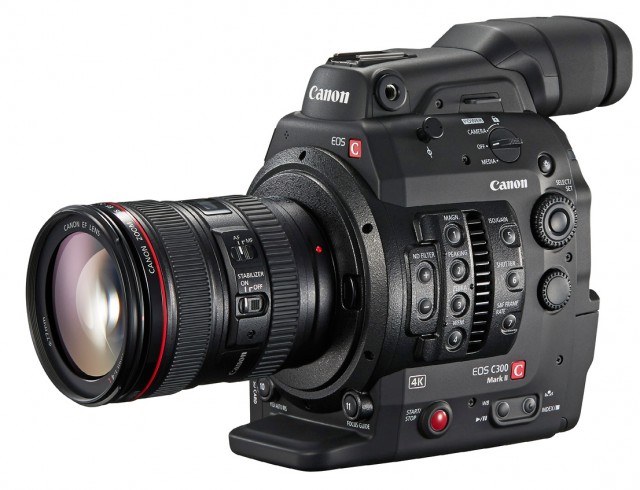It’s hard to believe that the Canon C300 was introduced 3 years ago. The camera has been very successful. Add a bunch of zeros after the 300 in the name, and you get very impressive numbers.
Now, Canon introduces the successor: EOS C300 Mark II. It records what almost everyone had been asking for: internal 4K. There are so many new features inside the familiar C300 body shape, maybe they should have named it the C400 or C4K. Prototypes will be on hand at Canon’s NAB booth.
The camera has a new 8.85 Megapixel Super 35mm 16:9 CMOS sensor that provides up to 4K (DCI) recording (4096 x 2160).
Here are some of the new things in the C300 Mk II:
- Sensor is 8.85 Megapixels: 4096 x 2160
- Records internally to AVC Intra 422 10-bit or Cinema RAW externally
- Rolling shutter issues have been eliminated because readout is 2x faster
- RAW recording via connectors at rear of camera.
- Internal ND filter cuts 8 and 10 stops of exposure in camera (previously the maximum was 6 stops)
- EVF can display a clean picture area without text. Information can be positioned outside the picture area, along the edges of frame.
- You can send a waveform via HD SDI to video village.
- Improved EFV and monito: sharper and clearer
- HD SDI and HDMI connections
- New battery: 12 VDC industry standard
- Beefier fan, no fan noise
- Dynamic range has been increased to an astonishing 15 stops. Dual DIGIC processors (two separate processors, working in parallel) “expose” the image at 2 different ISOs simultaneously, high and low.
- ISO: 100 – 102,400
- Sensitivity has been changed, we can now use lower ISOs (with the C300 it was recommended not to go below 640)
- Base ISO is 800 (instead of the light-meter vexing 850).
- Normal exposure latitude is 6.3 stops above and 8.7 below.
- Rec. 709, cine gamut, Rec. 2020, ACES compatible.
- Previous Canon log is still available.
- Slow shutter to ½ sec, timelapse
- 24-bit audio
- Dual pixel autofocus. Covers a wider area. Can tune autofocus parameters. Autofocus boost (auto/manual), Face detection, manual focus. Focus control wirelessly via iPad or iPhone with WiFi adapter.
- 3 indications of focus status: front, back and in-focus shown by arrows and colors. As you turn the lens barrel, the rectangle showing focus area turns green when sharp. You can position the rectangle with the joystick control.
- Cinema lenses now read out in f or T stops.
- Detachable cables to onboard monitor – different lengths.
- Handle unit is more practical, with more ¼-20 threads and cheeseplate attachment.
- Interchangeable mounts: comes standard in EF, with options for locking EF or PL mount. Mounts can be changed in the factory, at a qualified rental house or service facility.
- By the way, there are 12 EF mount Cinema EOS lenses now
- Maximum internal frame rate: 30 fps in 4K, 60 fps in 2K, 120 fps in HD
- An accessory audio interface has XLR audio connectors.
- Internal recording to CFast 2.0 cards in 60 or 128 GB capacities for 20 or 40 minutes in 4K. In 2K, recording time is greater than 2 hours.
- Shipping estimated September 2015.
- Price is expected to be similar to original C300, around $17,000.
NAB Booth C3628 and C4325
usa.canon.com/cusa/professional














